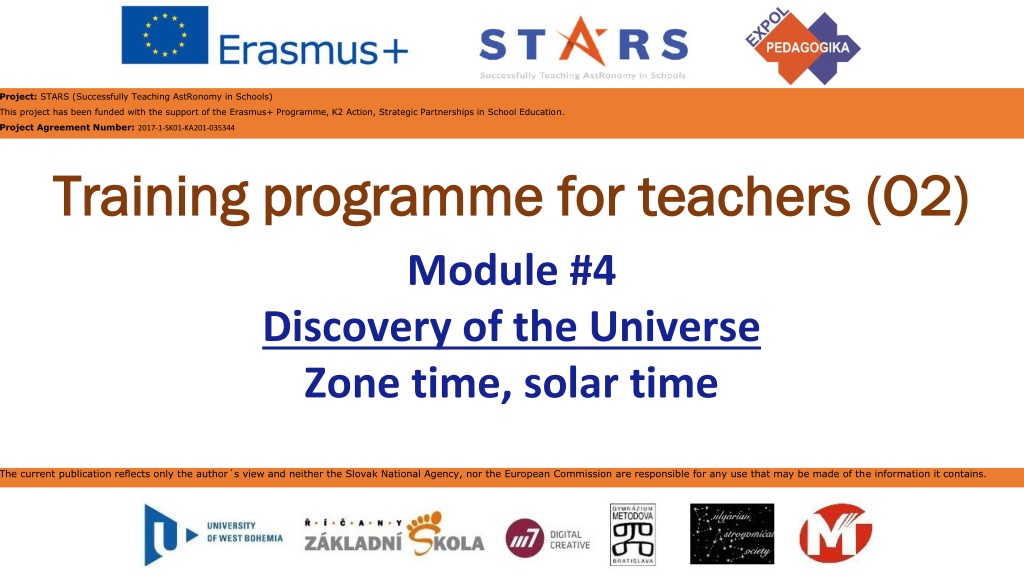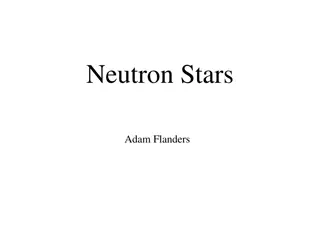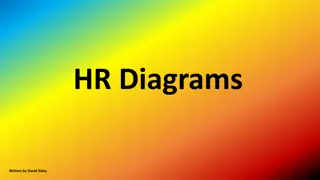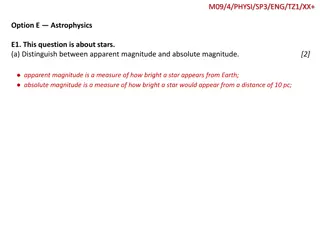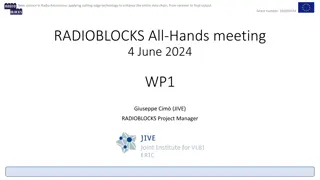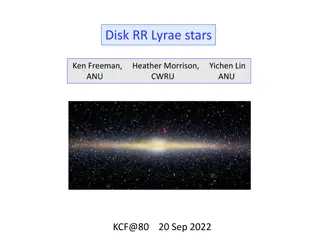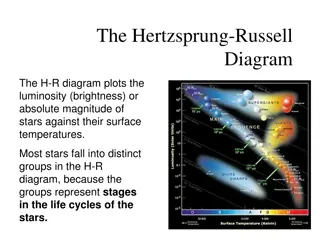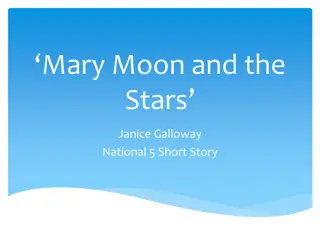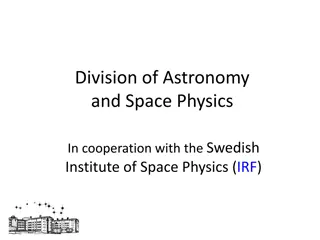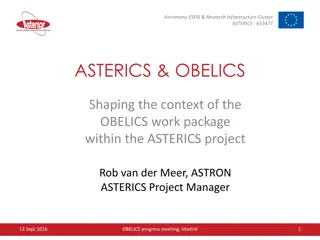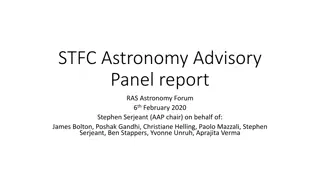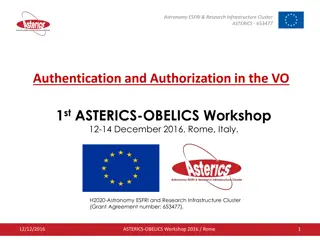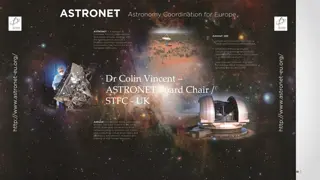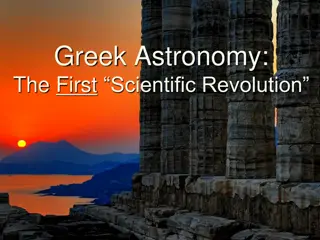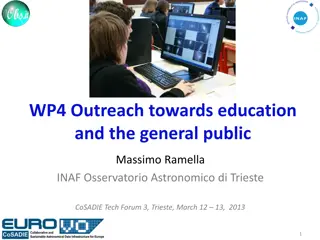STARS Project - Teaching Astronomy in Schools
The STARS (Successfully Teaching AstRonomy in Schools) Project, funded by Erasmus+ Programme, aims to provide innovative astronomy education resources for teachers through a training program and online platform. With modules covering topics from constellations to observatories, the project offers theoretical information and practical activities for classroom use. Teachers can access methodological handbooks, training programs, and engage in an international online conference to enhance their astronomy teaching skills. Explore the universe with the STARS Project today!
Download Presentation

Please find below an Image/Link to download the presentation.
The content on the website is provided AS IS for your information and personal use only. It may not be sold, licensed, or shared on other websites without obtaining consent from the author. Download presentation by click this link. If you encounter any issues during the download, it is possible that the publisher has removed the file from their server.
E N D
Presentation Transcript
Project: STARS (Successfully Teaching AstRonomy in Schools) This project has been funded with the support of the Erasmus+ Programme, K2 Action, Strategic Partnerships in School Education. Project Agreement Number:2017-1-SK01-KA201-035344 Training programme for teachers Training programme for teachers (O2) Module #4 Discovery of the Universe Zone time, solar time (O2) The current publication reflects only the author s view and neither the Slovak National Agency, nor the European Commission are responsible for any use that may be made of the information it contains.
Project STARS introduction 1. STARS Methodological Handbook for Teachers ready-to-use resource for teachers 2. STARS Training Program for Teachers innovative and comprehensive approach 3. STARS Online Platform with examples of good practice and opportunities for discussions and exchange 4. STARS Concept for Astronomy Education Program International Online Conference 2020 project-stars.com The current publication reflects only the author s view and neither the Slovak National Agency, nor the European Commission are responsible for any use that may be made of the information it contains.
Project STARS modules #1 #2 #3 #4 #5 Constellations. Motion of Celestial Bodies. Newton's law of Gravitation. Discovery of the Universe. Solar System. #6 #7 #8 #9 #10 Galactic Neighbourhood. Sun and Stars. Our Galaxy and other galaxies. The Universe. Observatories. The current publication reflects only the author s view and neither the Slovak National Agency, nor the European Commission are responsible for any use that may be made of the information it contains.
Structure of the modules There are several topics in each module. Each topic contains: A brief introduction and key words; Theoretical part for the teacher - provides the basic information, necessary for the planning a lesson on that topic (and links to additional information in some cases). Practical exercises and activities for the students - ready for use in the classroom (in most cases) and with answers provided where applicable. The current publication reflects only the author s view and neither the Slovak National Agency, nor the European Commission are responsible for any use that may be made of the information it contains.
How to work with the materials 1 1. Carefully read the theoretical part for the teacher. 2. Should questions arise, look for answers in the supplementary materials , on the project s website (project-stars.com), or other internet sites. Attention! Make sure the information is reliable! 3. Prepare the theoretical part of your lesson. The current publication reflects only the author s view and neither the Slovak National Agency, nor the European Commission are responsible for any use that may be made of the information it contains.
How to work with the materials 2 4. Read carefully the practical exercises and their answers. 5. Should questions arise, look for answers in the supplementary materials , on the project s website (project-stars.com), or other internet sites. Attention! Make sure the information is reliable! 6. Depending on the theoretical content of your lesson, choose appropriate practical activities to use. You can look for additional exercises in the supplementary materials or at the webpage of the project (project-stars.com), or other internet sites. Attention! Make sure the information is reliable! The current publication reflects only the author s view and neither the Slovak National Agency, nor the European Commission are responsible for any use that may be made of the information it contains.
How to work with the materials 3 7. Keep in mind that some of the activities require materials that should be available during the lesson. 8. We recommend you try out the activities yourself before presenting them in the classroom. Based on yours students ages and abilities, you might need to modify the activities (either to make them easier or more difficult). However make sure to keep them correct in terms of physics. 9. You can give parts of, or whole exercises as homework. The current publication reflects only the author s view and neither the Slovak National Agency, nor the European Commission are responsible for any use that may be made of the information it contains.
dule 4 contents 4.1 Time Zone time, solar time. The current publication reflects only the author s view and neither the Slovak National Agency, nor the European Commission are responsible for any use that may be made of the information it contains.
Theoretical contents 4.1 Time True solar time and mean solar time; sidereal time; coordinated universal time; zone time; measuring time with a clock. The current publication reflects only the author s view and neither the Slovak National Agency, nor the European Commission are responsible for any use that may be made of the information it contains.
List of Practical activities 4.1.1 4.1.2 Zone time Mean solar time and true solar time The current publication reflects only the author s view and neither the Slovak National Agency, nor the European Commission are responsible for any use that may be made of the information it contains.
Practical activity: 4.1.1 Zone time Methodical part: The activity is focused on working with the map and calculations on a calculator. Material and tools: Map of Czech Republic, world map, time zone map Postup: Pupils will get acquainted with the concept of zone time and its application in various parts of our republic and in various locations around the world. The tasks are chosen to lead to an understanding of the nature of time zone. The current publication reflects only the author s view and neither the Slovak National Agency, nor the European Commission are responsible for any use that may be made of the information it contains.
commons.wikimedia.org/wiki/File:World_Time_Zones_Map.png Practical activity: 4.1.1 Zone time The current publication reflects only the author s view and neither the Slovak National Agency, nor the European Commission are responsible for any use that may be made of the information it contains.
Practical activity: 4.1.1 Zone time 1. Find on the map of the Czech Republic some city that lies at the 15th meridian of eastern longitude. Next, find the easternmost point and the westernmost point. Determine their geographic coordinates. the westernmost point 50 15 ; 12 05 the easternmost point 49 55 ; 18 52 e.g. Jind ich v Hradec 49 09'; 15 00' The current publication reflects only the author s view and neither the Slovak National Agency, nor the European Commission are responsible for any use that may be made of the information it contains.
Practical activity: 4.1.1 Zone time 2. On the 15th meridian, the sun rises on a certain day at 6.00 am and sets at 6.00 pm. At what time does the sun rise and set in the easternmost and westernmost place of the Czech Republic? Neglect the altitude of the place and its surroundings. The difference in longitude between the easternmost place in the Czech Republic and the 15th meridian is 3 52', between the westernmost place in the Czech Republic and the 15th meridian it is 2 55'. Because a 15 longitude difference means a difference of 1 hour (360 degrees mean 24 hours), a 1 longitude difference means a 4 minute difference. In the easternmost place of the Czech Republic, the sun rises and sets 15.5 minutes earlier, in the westernmost place 11.5 minutes later. The current publication reflects only the author s view and neither the Slovak National Agency, nor the European Commission are responsible for any use that may be made of the information it contains.
Practical activity: 4.1.1 Zone time 3. Find a place on the map where the sun rises on the same day at 5.50 am. A difference of 10 minutes means a difference of 2.5 longitude from the meridian of 15 . The sought-after place therefore lies at the meridian of 17.5 . For example, the town of Tluma ov is located on this meridian. The current publication reflects only the author s view and neither the Slovak National Agency, nor the European Commission are responsible for any use that may be made of the information it contains.
Practical activity: 4.1.1 Zone time 4. The sun set in Plze at 4.16 pm. What time did the sun set in r nad S zavou? Neglect the altitude of both places and their surroundings. Plze 49 44 ; 13 23 ; r nad S zavou 49 34 ; 15 56 ; the longitude difference is 2 33 . The sunset time difference is 10,2 minutes. The sunset took place in r nad S zavou at 4.06 pm. In this case, we consider only the difference in longitude, which is sufficient at the primary school level. If the latitude also differs significantly (here it differs only by 10 angular minutes), it is necessary to make a correction to the latitude, which, however, exceeds the curriculum of the primary school. For those interested, the description is available in the Observatory Yearbook, e.g. rocenka.observatory.cz/2019/slunce.html. The date of the sunset would have to be added to the entry in order to determine the azimuth of the sunset. The sun sets in Pilsen at 4.16 pm on January 1st in an azimuth of 234 (astronomical azimuth is 54 , calculated from the south). The error in determining the sunset at latitude would be less than 1 minute in this case. The current publication reflects only the author s view and neither the Slovak National Agency, nor the European Commission are responsible for any use that may be made of the information it contains.
Practical activity: 4.1.1 Zone time 5. There is a 6:00 am time in Prague on December 3. What is the date and time in Tokyo, Sydney, Cairo, Ottawa? Tokyo lies in a time zone with 9 hours difference from universal time. There is 8 hours more than in Prague, i.e. December 3rd 2 pm. Similarly, in Sydney (+ 10 hours compared to universal time), it is 3 pm. It is 7 am in Cairo (+ 2 hours). Ottawa is located in a zone with a time less than 5 hours from universal time. There is therefore 6 hours less than in Prague, so it is midnight from December 2nd to 3rd. The current publication reflects only the author s view and neither the Slovak National Agency, nor the European Commission are responsible for any use that may be made of the information it contains.
Practical activity: 4.1.1 Zone time 6. For time zones, it is often simply stated that the Earth is divided into 12 zones delimited by meridians with a bandwidth of 15 degrees, in which the time zone is given by the time of the meridian 15 lying in the middle of the zone. Using a time zone map, indicate what other factors affect what time zone is used in a given location. Are there places where the time zone differs from universal time by a time that cannot be expressed in whole hours? A very significant factor influencing what time zone is used in a given place is the border of a state or group of states. On some islands in the southern latitudes, time is used that differs by odd multiples of half an hour. For example, the Cocos Islands (+ 6.5 h), the Andaman and Nicobar Islands (+ 5.5 h), but also, for example, the central part of Australia (+ 9.5 h). In the southern part of Australia there is an area with a time of + 8.75 h compared to universal time, near New Zealand the Chatham Islands (+ 12.75 h), etc. The current publication reflects only the author s view and neither the Slovak National Agency, nor the European Commission are responsible for any use that may be made of the information it contains.
Practical activity: 4.1.1 Zone time 7. Find out what a date line is. Describe its course on a map of the Earth and explain its meaning. How should a person proceed correctly when crossing the date line from east to west, and how to fly in the opposite direction? How did the date line on Willy Fog's journey around the world manifest itself? The limit set by an international agreement, beyond which the date changes. It passes through the meridian of longitude 180 longitude. It is designed to go as far away from human civilization as possible. It avoids continents and islands, closest to solid land (outside Antarctica) passes between the Diomede Islands in the Bering Strait. When crossing the data limit, it is necessary to adjust the date so that it is one day less east of the data limit than west of it. In the absence of an international date limit, travelers who travel the entire west of the Earth would miss one day on their calendar when they return. For those who circumnavigated the Earth to the east, one day would reside. This happened to Willy Fogg in the animated series Willy Fog on a trip around the world inspired by Jules Verne's novel A Trip Around the World in 80 Days. The current publication reflects only the author s view and neither the Slovak National Agency, nor the European Commission are responsible for any use that may be made of the information it contains.
Practical activity: 4.1.2 Mean and true solar time Methodical part: The activity is long-term, one year, and it takes about 10 minutes each day, the final data processing 1 hour. Material and tool: Sun dial, watch or mobile phone Procedure: Pupils will understand the difference between true and mean solar time. The current publication reflects only the author s view and neither the Slovak National Agency, nor the European Commission are responsible for any use that may be made of the information it contains.
Practical activity: 4.1.2 Mean and true solar time 1. The sundial measures the local apparent solar time, which differs from the mean solar time relative to the respective meridian within the time zone. The exercise aims to map the relationship between apparent and mean solar time during a calendar year. First, choose the time that will be as suitable as possible for regular year-round monitoring (so that measurements can be taken at this time throughout the year), for example 3 pm. Remember that this time can only be between 8 am and 4 pm, because in the winter months there is night from about 4 pm to about 8 am. Then measure the exact time (per minute) each day when the sundial shows 3 pm. Record the measured times gradually, preferably in a computer spreadsheet. Date Solar time Exact time 3 pm The current publication reflects only the author s view and neither the Slovak National Agency, nor the European Commission are responsible for any use that may be made of the information it contains.
Practical activity: 4.1.2 Mean and true solar time 2. Calculate the difference between the local time and the time zone given by the longitude of the observation site and indicate it above the table. Then enter the recalculated times corresponding to 3 pm in the sundial in a new column in the table. Date Solar time Exact time Recalculated time 3 pm The current publication reflects only the author s view and neither the Slovak National Agency, nor the European Commission are responsible for any use that may be made of the information it contains.
Practical activity: 4.1.2 Mean and true solar time 3. Draw a graph of the dependence of the difference between apparent solar time and mean solar time. Find out what this difference is called in astronomy. time equation kalendar.beda.cz/o-casu The current publication reflects only the author s view and neither the Slovak National Agency, nor the European Commission are responsible for any use that may be made of the information it contains.
Practical activity: 4.1.2 Mean and true solar time 4. Using the Internet, describe why the difference between true and mean time changes during the year. Which two characteristics cause the change? the inclination of the Earth's axis and the elliptical trajectory of Earth around Sun The current publication reflects only the author s view and neither the Slovak National Agency, nor the European Commission are responsible for any use that may be made of the information it contains.
Practical activity: 4.1.2 Mean and true solar time 5. Explain the saying Lucia shortens the night, but does not add to the day . Use the terms: true solar time, mean solar time, sunset, length of day The sun sets on the day of St. Lucia (December 13th) at the earliest of the year. If it raised on this day at the latest time as well, it would be the shortest day. However, the latest sunrise does not occur until the beginning of January. Therefore, the shortest white day is most often on December 20th. The fact that the earliest sunset and the latest sunrise do not occur on the same day is caused by the uneven orbit of the Earth around the Sun and the uniform rotation of the Earth around its axis. The saying about St. Lucia is a manifestation of the time equation, i.e. the fluctuation of the length of the time equation during the year. The mentioned saying thus makes the difference between the apparent and mean solar time visible. The current publication reflects only the author s view and neither the Slovak National Agency, nor the European Commission are responsible for any use that may be made of the information it contains.
Conclusions, results check 1 Feed Forward: Base your plans for the next lessons on the results of the pupils: Difficulty of the lessons: depending on pupils comprehension of the material and level of completion of the activities. Preparation: Clear and well appointed goals of the lesson and activities. When the goal is well understood, the attention towards a task/material is easier and more effective. Approach toward the material: What would be the correct approach that would help the student comprehension and activity completion. The current publication reflects only the author s view and neither the Slovak National Agency, nor the European Commission are responsible for any use that may be made of the information it contains.
Conclusions, results check 2 Self-evaluation: self-discipline, steering and control of the activities. Individual approach: Individual approach and guidance. Check: How did I do? Individual evaluation of the pupil s work, pertaining to the specific activity and goal. Must contain information about the advance (or lack of) the pupil has made and to guide them to achieve the goals and standards. The current publication reflects only the author s view and neither the Slovak National Agency, nor the European Commission are responsible for any use that may be made of the information it contains.
